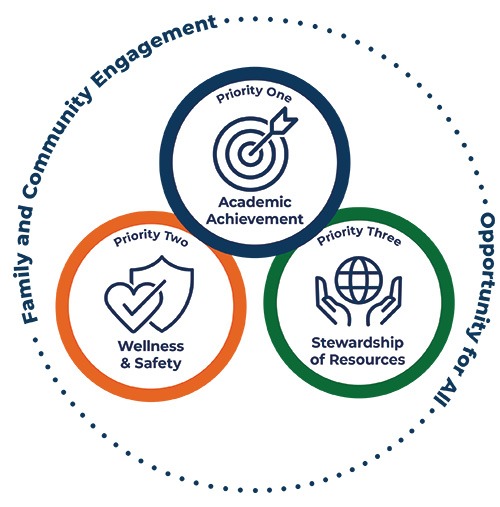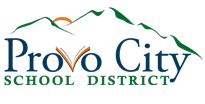Last modified: November 12, 2024
District Strategic Plan 2025-2030
- Download 2025-2030 Strategic Plan
- Download One Page Overview of 2025-2030 Strategic Plan
- Strategic Plan Podcast Part 1
- Strategic Plan Podcast Part 2
Mission
Welcome, Educate & Inspire
Vision
The Provo City School District is a vibrant learning environment where all students become lifelong learners and engaged community members.
Core Values
Belonging
Creating a welcoming and supportive environment where differences are valued and everyone feels respected and included.
Growth
Striving for academic rigor, innovative teaching methods, and continuous improvement to foster student success and achievement.
Empowerment
Providing tools, resources, and opportunities to build confidence, develop capacity, and achieve greatness.
Creativity
Encouraging innovation, curiosity, imagination, and critical thinking.
Community
Establishing strong partnerships between schools, families, and the broader community to enhance educational experiences and address needs of students effectively.
Priorities

Priority 1: Academic Achievement
Goal
- Increase the percentage of students achieving proficiency in core subjects (M/LA/S) by 15% within 5 academic years.
Strategies
- Ensure all students have access to and engagement with high-quality Tier 1 instruction including differentiated instructional strategies & regular formative assessments, to address individual learning needs.
- Analyze data by student group for the district and schools and implement systematic, targeted Tier 2 and Tier 3 evidence-based interventions.
- Provide professional development opportunities for teachers to enhance their instructional practices, including student engagement strategies.
Key Performance Indicators (KPIs)
Measured by end of level state assessment
|
Year |
Language Arts | Math | Science |
|---|---|---|---|
| 2025 |
51% |
46% |
48% |
| 2026 |
54% |
49% |
51% |
| 2027 |
57% |
52% |
54% |
| 2028 |
60% |
55% |
57% |
| 2029 | 63% | 58% | 60% |
| 2030 | 66% | 61% | 63% |
Goal
- Increase the percentage of students who meet college & career readiness benchmarks (ACT >18, Graduation, Adv. Courses) by 5% within 5 academic years.
Strategies
-
Ensure each student is prepared for the rigors of college, technical or vocational training, or career training to maximize success in postsecondary opportunities.
-
Ensure each student successfully completes at least one Advanced Placement or Concurrent Enrollment course or a sequence of Career and Technical Education courses that comprise a CTE pathway.
Key Performance Indicators (KPIs)
Postsecondary Readiness Indicators established by Utah State Board of Education
|
Year |
Language Arts | Math | Science |
|---|---|---|---|
| 2025 |
68% |
92% |
80% |
| 2026 |
69% |
93% |
81% |
| 2027 |
70% |
94% |
82% |
| 2028 |
71% |
95% |
83% |
| 2029 | 72% | 96% | 84% |
| 2030 | 73% | 97% | 85% |
Priority 2: Wellness and Safety
Goal
- Increase the number of students and families who feel that our schools and district provide welcoming and supportive environments as measured by climate and stakeholder feedback surveys.
Strategies
- Educate and mentor all employees in how to create a welcoming atmosphere for all community members and students.
- Increase opportunities for and participation in family engagement opportunities and ensure that parents who attend are representative of the district’s population.
- Create specific district wide committees for families and employees to have access to high levels of leadership to problem-solve situations as they arise in our district.
Key Performance Indicators (KPIs)
|
Year |
Utah State Board of Education Climate Survey |
|---|---|
| 2025 |
Baseline survey data |
| 2026 |
Improve survey data scores by 4% over baseline in 3 priority areas. |
| 2027 |
Improve survey data scores by 8% over baseline in 3 priority areas. |
| 2028 |
Improve survey data scores by 12% over baseline in 3 priority areas. |
| 2029 | Improve survey data scores by 16% over baseline in 3 priority areas. |
| 2030 | Improve survey data scores by 20% over baseline in 3 priority areas. |
Goal
- Reduce the number of major offenses tied to bullying, harassment, discrimination, school safety, and physical aggression to 4% or lower across all student groups by 2030.
Strategies
-
Implement a Levels of Behavior policy and train all teachers and administrators in these protocols. Measure the effectiveness through Office Discipline Referral Data reported on Powerschool as well as SafeUT reports.
-
Implement a successful PBIS system at each school site that is measured by a school-wide evaluation tool (SET).
Key Performance Indicators (KPIs)
|
Year |
Office Discipline Referrals (ODRs)as measured by Powerschool and SafeUT reports |
|---|---|
| 2025 |
Baseline ODR data |
| 2026 |
Drop in ODRs by 2% for all student groups |
| 2027 |
Drop in ODRs by 4% for all student groups |
| 2028 |
Drop in ODRs by 6% for all student groups |
| 2029 | Drop in ODRs by 8% for all student groups |
| 2030 | Drop below 4% in ODRs for all student groups |
Goal
- Decrease the number of students who are chronically absent by 20% by 2030.
Strategies
- Implement evidence-based strategies to improve attendance.
Key Performance Indicators (KPIs)
|
Year |
Chronic absenteeism data |
|---|---|
| 2025 |
Baseline survey data |
| 2026 |
Decrease by 4% from baseline |
| 2027 |
Decrease by 8% from baseline |
| 2028 |
Decrease by 12% from baseline |
| 2029 | Decrease by 16% from baseline |
| 2030 | Decrease by 20% from baseline |
Priority 3: Stewardship of Resources
Goal
- Increase the retention of high quality teachers between years 5 and 15 by 15% over 5 years.
Strategies
- Implement an employment satisfaction survey to identify areas of improvement and success to reduce employee turnover.
- Work with employee groups to create plans to improve benefits and salaries.
- Provide support for employees with continued professional development.
Key Performance Indicators (KPIs)
|
Year |
Employee Satisfaction Survey |
|---|---|
| 2025 |
Baseline survey data |
| 2026 |
Improve survey data scores by 3% over baseline in 3 priority areas. |
| 2027 |
Improve survey data scores by 6% over baseline in 3 priority areas. |
| 2028 |
Improve survey data scores by 9% over baseline in 3 priority areas. |
| 2029 | Improve survey data scores by 12% over baseline in 3 priority areas. |
| 2030 | Improve survey data scores by 15% over baseline in 3 priority areas. |
Goal
- Improve communication about decision-making, resource allocation, and facilities management by 15% over 5 years as measured by specific survey data.
Strategies
- Provide meaningful data and transparency to the community about our decision-making processes.
- Provide effective communication to all stakeholders through regular email, board updates, newsletters, in-person community meetings, social media platforms, videocasts, and podcasts.
Key Performance Indicators (KPIs)
|
Year |
Community Survey |
|---|---|
| 2025 |
Baseline survey data |
| 2026 |
Improve survey data scores by 3% over baseline in 3 priority areas. |
| 2027 |
Improve survey data scores by 6% over baseline in 3 priority areas. |
| 2028 |
Improve survey data scores by 9% over baseline in 3 priority areas. |
| 2029 | Improve survey data scores by 12% over baseline in 3 priority areas. |
| 2030 | Improve survey data scores by 15% over baseline in 3 priority areas. |

